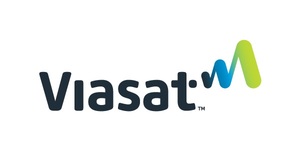ViaSat, the University of Aberdeen, NHS Highland and the Scottish Ambulance Service Trial New Connected Ambulance Program to Bring Enhanced Emergency Care to Patients in Transit
FARNBOROUGH, England, Nov. 13, 2017 /PRNewswire/ -- ViaSat Inc. (NASDAQ: VSAT) a global broadband services and technology company, today announced it is working with The University of Aberdeen's Centre for Rural Health, NHS Highland and the Scottish Ambulance Service on a pilot program called SatCare, which will enable paramedics to send high-resolution video and ultrasound images from connected ambulances to hospital-based medical experts, ahead of a patient's hospital arrival. The connected ambulances will utilise ViaSat's advanced satellite communications system, operating on its jointly-owned KA-SAT high throughput satellite network.
The one-year SatCare trial, partly-funded by the European Space Agency (ESA), aims to help approximately 1,000 patients living in remote and rural Scotland. The goal is to provide better patient care on long ambulance journeys, as well as provide more streamlined care upon hospital arrival, such as immediate transfer to an operating theatre.
As part of the pilot, five Scottish ambulances have been equipped with state-of-the-art scanning equipment and ViaSat's satellite broadband communications system. Scans that take a paramedic less than 5 minutes to record and package with a video summary of the patient's condition will be transmitted in seconds over ViaSat's satellite system to the emergency department of Raigmore Hospital in Inverness, Scotland. The hospital experts will then assess the patient's needs, give medical advice to the paramedic in transit, and mobilise resources or specialist teams required for the patient's arrival.
The SatCare technology has been successfully tested using healthy volunteers. It will now be put into trial, helping several potentially life-threatening conditions, including: major trauma, chest pain, shortness of breath, abdominal pain and circulatory shock, all of which could benefit from more accurate early diagnosis.
Supporting Quotes:
- Dr. Leila Eadie, Research Fellow at the University of Aberdeen's Centre for Rural Health, explains: "We are taking diagnostic tools used in the emergency department into rural ambulances, making them available at the site of an emergency. Previous studies have shown the biggest barrier to practical use of pre-hospital ultrasound is interpretation of the scans: images can be acquired with basic training and SatCare communications technology will facilitate expert assessment of images in the field. We want to maximise the benefits of having ultrasound available without requiring paramedics to undertake extensive sonography training."
- Dr. Luke Regan, Emergency Consultant at Raigmore Hospital, said: "Point-of-care ultrasound, telemedicine and remote decision support have all offered potential over the years to improve care for our patients, but have often failed to secure the kinds of rigorous and substantial research platforms that allow firm conclusions to be made about efficacy. The SatCare trial aims for the numbers, methodological rigour and rural patient base to offer a real prospect of informing the debate on these interventions positively for years to come."
- Professor Philip Wilson, Director of the Centre for Rural Health, said: "This trial is a landmark in rural emergency care research. It will establish the best way to use very sophisticated technology to support paramedics in caring for sick patients on the long journey to a hospital and to alert A&E staff to what kind of treatments may be needed when the patient arrives. This research will tell us how effective and, equally important, how cost-effective this technology can be."
- Marc Agnew, vice president, ViaSat Europe, said: "The innovative satellite broadband communication solutions we have created for the SatCare trial will allow transmission of high-bandwidth video summaries and ultrasound scans in areas of the Highlands where mobile phones and traditional emergency communication services have encountered problems. The equipment is simple to use, easy to install and most importantly can potentially bring considerable benefits to both paramedics and patients in emergency situations."
- Neil Fraser, director of space and communications, ViaSat UK, said: "This ESA-sponsored medical project aligns with ViaSat UK's recent efforts to grow our engineering talent pool and expand our technology repertoire. Critical elements of this project were developed and integrated in our recently expanded R&D facility in Farnborough. Working closely with our partners on this trial, we will be seeking to further enhance this capability for first responders."
About ViaSat
ViaSat, Inc. (NASDAQ: VSAT) keeps the world connected. As a global broadband services and technology company, ViaSat ensures consumers, businesses, governments and military personnel have communications access - anywhere - whether on the ground or in-flight. The Company's innovations in designing highest-capacity satellites and secure ground infrastructure and terminal technologies coupled with its international network of managed Wi-Fi hotspots enable ViaSat to deliver a best available network that extends the reach and accessibility of broadband internet service, globally. For more information visit ViaSat at: www.viasat.com, or follow the Company on social media: Facebook, Twitter, LinkedIn and YouTube.
Forward Looking Statement
This press release contains forward-looking statements that are subject to the safe harbors created under the Securities Act of 1933 and the Securities Exchange Act of 1934. Forward-looking statements include, among others, statements that refer to the SatCare program and the ability to transmit scans over the KA-SAT satellite in Europe in order to provide better patient care on long ambulance journeys; more streamlined care upon hospital arrival; and our ability, talent pool and timeline to bring connected ambulance type of solutions to first responders. Readers are cautioned that actual results could differ materially from those expressed in any forward-looking statements. Factors that could cause actual results to differ include: the ability to realize the anticipated benefits of the KA-SAT satellite platform; unexpected expenses or delays related to the satellite system; the ability to successfully implement ViaSat's business plan for broadband satellite services on ViaSat's anticipated timeline or at all, including with respect to the KA-SAT satellite platform; and risks associated with the effect of any anomaly, operational failure or degradation in satellite performance; the impact of competition; the ability to develop products and technologies; the impact of changes in the financial markets and global economic conditions; changes in relationships with, or the financial condition of, key customers or suppliers; reliance on a limited number of third parties to manufacture and supply products; ViaSat's level of indebtedness and ability to comply with applicable debt covenants; and other factors as may be detailed from time to time in ViaSat's public announcements and SEC filings. In addition, please refer to the risk factors contained in ViaSat's SEC filings available at www.sec.gov, including ViaSat's most recent Annual Report on Form 10-K and Quarterly Reports on Form 10-Q. Readers are cautioned not to place undue reliance on any forward-looking statements, which speak only as of the date on which they are made. ViaSat undertakes no obligation to update or revise any forward-looking statements for any reason.
Copyright © 2017 ViaSat, Inc. All rights reserved. All other product or company names mentioned are used for identification purposes only and may be trademarks of their respective owners. ViaSat is a registered trademark of ViaSat, Inc.




Share this article